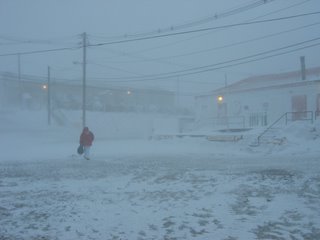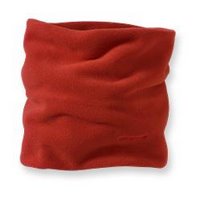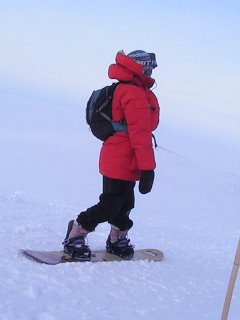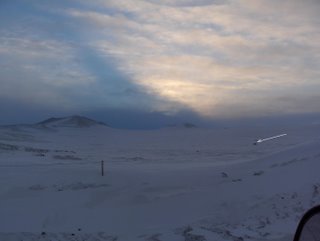 we walk by sound, not by sight.
we walk by sound, not by sight.mcmurdo had a pretty good blizzard this past week.
on tuesday, a low pressure system moved into the area, resulting in high winds and blowing snow all over town. the airstrip was completely obscured from view, and drifts were piling up in doorways and alleys.
on wednesday morning at around 1030, mac weather (the weather observers and forecasters) called the chalet and told us that the storm was pretty bad, and set to worsen within a few hours. they recommended that we contact all work centers and have managers account for all their personnel. everyone working outside or on the runway was brought into a building where, if a condition I was called, they would be warm, comfortable, and have access to food and drink. (during a condition I, no one is allowed to leave whatever building they happen to be in at the time. if you must leave, you need to call the firehouse for an escort. if the condition I encompasses a mealtime, you can get to the dining hall by following a 'lifeline' set up by the JSART - the Joint Search and Rescue Team.)
 the wind picked up. visibility was for jack. I spent the final hour of the morning calling departmental directors, asking them to account for all their workers. 'non-essential' personnel were sent home from work at around lunchtime. we ate lunch in the galley, looking out the large glass picture windows at the swirling white outside. ob hill was completely obscured. we could barely see the medical building, a hundred feet away.
the wind picked up. visibility was for jack. I spent the final hour of the morning calling departmental directors, asking them to account for all their workers. 'non-essential' personnel were sent home from work at around lunchtime. we ate lunch in the galley, looking out the large glass picture windows at the swirling white outside. ob hill was completely obscured. we could barely see the medical building, a hundred feet away.a bunch of us decided to watch a movie in one of the dorm lounges that afternoon. someone suggested National Treasure, the nicholas cage movie from a couple of years ago. I had been curious to see the movie because a number of friends had mentioned these snow-tracked vehicles in it and had wondered if I drove something similar during my stint as a shuttle operator last season. the movie was cheesy fluff, of course. I grow weary of post-Leaving Las Vegas nicholas cage. (it seems to me, upon seeing 8 Below and now National Treasure, both Disney films, that Disney feels the need to include a goofy male character in all their films, someone who provides comic relief in tense situations and makes the male lead seem even more attractive to the female lead because he doesn't, unlike the goofy
 male character, live with his parents, make rude noises with his body, have crushes on unattainable foreign women, fall down helplessly when sled dogs lick his face, and so forth.) all this to say, however, that during the viewing, we actually felt the building shake. like someone was running into it with a bulldozer. winds outside were 50+ knots. and the snow vehicles in the film? yeah, we have something similar, called Tucker Terras. the ones in the movie were shinier, though.
male character, live with his parents, make rude noises with his body, have crushes on unattainable foreign women, fall down helplessly when sled dogs lick his face, and so forth.) all this to say, however, that during the viewing, we actually felt the building shake. like someone was running into it with a bulldozer. winds outside were 50+ knots. and the snow vehicles in the film? yeah, we have something similar, called Tucker Terras. the ones in the movie were shinier, though.the following morning, the winds had not yet abated, but condition I had not been called, so everyone reported to work at 0730 as usual. I left the dining hall and set out for the chalet, a couple of hundred yards away across a large open space near the crary laboratory and the science support center. as I got closer to the large open space, the wind got stronger. I had trouble standing up straight, much less walking, and was actively leaning forward somewhere between 60 and 75 degrees. my hood was acting as a sail, so I had to hold onto the furry edge of it and draw it down over my face, both to keep blowing snow from going down my collar and to prevent me from falling over backward. I tried to keep my chin tucked into my neck gaiter, and that helped, but my cheeks were going numb.

neck gaiters, by the way, are my favorite piece of antarctic clothing, the perfect jeans of extreme-cold-weather gear. they're nothing more than a little tube of polar fleece or something else warm and fuzzy, and they cover you from chin to collar, which works WONDERS in keeping your whole body warm. when your neck gets hot, you can move it up and wear it as a sort of topless hat. I've knitted a few for people as well. last season I made one out of this nubby gray-and-brown yarn my parents bought me in japan, and when I wear it on my head, it makes me look like a nuclear cooling tower or perhaps a furry lampshade.
I couldn't see anything more than a couple of feet in front of me. everything was white. I knew that the chalet was roughly straight ahead, but off to the right side of it was an incline that would take me downhill toward the helicopter pad, where I decidedly did NOT want to go.
under the sound of the wind howling down the pass was another, more staccato sound. it was familiar, and seemed to get louder as I walked. I realized what it was. there is a flagpole on the chalet deck, on the south side of the building. there's an american flag on it. that's what I was hearing -- the flag flapping madly in the wind. I followed it all the way to the front steps.

here's a photo of rhoda, one of the mechanics on the AGE (airfield ground equipment) team, after the wednesday storm. she got a little surprise when she opened the back door.
every sunday night, a grantee gives a presentation to the wider mcmurdo community about whatever he or she is researching. talks range from glaciers to penguins to atmospheric balloons to volcanoes to icebergs. tonight, the presentation is a film, and the grantee is a filmmaker. her name is anne aghion, and she makes documentaries. she's here as part of the NSF's artists & writers program to make a film about the people who come to work in antarctica. (werner herzog, another filmmaker whose latest work in the theatres was Grizzly Man, will be here later in the season as part of the same program. according to his proposal, he wants to capture the 'ecstatic truth' of the continent. yes, he actually used that phrase. very cool.)
anne's two previous films are about the mass killings in rwanda in 1994, and the country's struggle to live in the aftermath of these killings. a few weeks ago, she showed her first film, Gacaca: Living Together Again?, and tonight's film is called In Rwanda We Say: The Family that Does Not Speak Dies. it won an Emmy award.
anne is interviewing people down here to use as possible footage for her next film, and she interviewed me on thursday. I have no idea whether I'll end up in the finished product, but who knows?
you can read more about anne's work at http://www.anneaghionfilms.com/.
last weekend, there was a party at Scott Base, the kiwi base down the road from us. the theme
 was the letter 'P' -- and so your costume had to be something that starts with the letter P. there were the usual prostitutes, pimps, priests and prisoners, but also some admirably creative costumes -- a planet, a proctologist (complete with a rubber glove smeared with something brown and unspeakable), a black-eyed pea, the phantom of the opera, a parisian girl, a pyromaniac, and a pee flag (the yellow flag that marks the place in the snow where you should pee). here I am with my friends barry, michael and amber. we are -- respectively -- a plumber (which was boring on barry's part because he IS a plumber in real life), a panda (I tried coloring my nose black with eyeliner, but it just ended up looking creepy so I took it off), psilocybin (the chemical compound in magic mushrooms), and a pohnpeian woman (pohnpei is an island in micronesia, where amber lived for seven years). it's amazing what sorts of props and things you can come up with eight thousand miles from home.
was the letter 'P' -- and so your costume had to be something that starts with the letter P. there were the usual prostitutes, pimps, priests and prisoners, but also some admirably creative costumes -- a planet, a proctologist (complete with a rubber glove smeared with something brown and unspeakable), a black-eyed pea, the phantom of the opera, a parisian girl, a pyromaniac, and a pee flag (the yellow flag that marks the place in the snow where you should pee). here I am with my friends barry, michael and amber. we are -- respectively -- a plumber (which was boring on barry's part because he IS a plumber in real life), a panda (I tried coloring my nose black with eyeliner, but it just ended up looking creepy so I took it off), psilocybin (the chemical compound in magic mushrooms), and a pohnpeian woman (pohnpei is an island in micronesia, where amber lived for seven years). it's amazing what sorts of props and things you can come up with eight thousand miles from home. happy happy weekend! sunday for me, saturday for you.
happy happy weekend! sunday for me, saturday for you.







